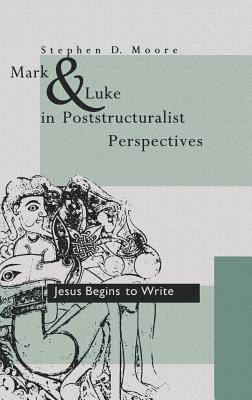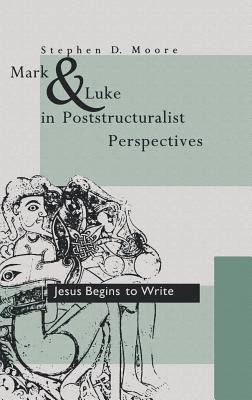
Je cadeautjes zeker op tijd in huis hebben voor de feestdagen? Kom langs in onze winkels en vind het perfecte geschenk!
- Afhalen na 1 uur in een winkel met voorraad
- Gratis thuislevering in België vanaf € 30
- Ruim aanbod met 7 miljoen producten
Je cadeautjes zeker op tijd in huis hebben voor de feestdagen? Kom langs in onze winkels en vind het perfecte geschenk!
- Afhalen na 1 uur in een winkel met voorraad
- Gratis thuislevering in België vanaf € 30
- Ruim aanbod met 7 miljoen producten
Zoeken
Mark and Luke in Poststructuralist Perspectives
Jesus Begins to Write
Stephen D Moore
Hardcover | Engels
€ 106,95
+ 213 punten
Omschrijving
"What is the lesson of that other, newly sprung tree (the cross) in whose bark Mark has carved his Gospel (for this is a book that bleeds)? Is it that Jesus's body, grafted onto the cross, became one with it, and thus became tree, branch, book, and leaf, inscribed with letters of blood, can now at last be read, no longer an indecipherable code but an open codex? And that in its (now) re(a)d(able) ink, lately invisible, the message that was scratched into the fig tree is transcribed: outside the gates, but only just, the summer Son is shining in full strength?"--Stephen D. Moore
In this book Stephen D. Moore offers a dazzling new reading of the Gospels of Mark and Luke, applying the poststructuralist techniques of Derrida, Lacan, and Foucault to illuminate these texts in a way that no one has done before. Written with wit and a sensitivity to words--and wordplay--that is reminiscent of Moore's fellow countryman James Joyce, the book is also deeply learned, impressive in its detailed knowledge of previous scholarship as well as in the challenges it presents to that scholarship.
Moore argues that whereas the language of the Gospels is concrete, pictorial, and often startling, the language of modern gospel scholarship tends to be propositional and abstract. Calling himself a New Test-what-is-meant scholar, he approaches the Gospels of Mark and Luke as though they were pictograms or dreamwork to decipher and interpret, writing a response that is no less visceral and immediate than the biblical texts themselves.
In this book Stephen D. Moore offers a dazzling new reading of the Gospels of Mark and Luke, applying the poststructuralist techniques of Derrida, Lacan, and Foucault to illuminate these texts in a way that no one has done before. Written with wit and a sensitivity to words--and wordplay--that is reminiscent of Moore's fellow countryman James Joyce, the book is also deeply learned, impressive in its detailed knowledge of previous scholarship as well as in the challenges it presents to that scholarship.
Moore argues that whereas the language of the Gospels is concrete, pictorial, and often startling, the language of modern gospel scholarship tends to be propositional and abstract. Calling himself a New Test-what-is-meant scholar, he approaches the Gospels of Mark and Luke as though they were pictograms or dreamwork to decipher and interpret, writing a response that is no less visceral and immediate than the biblical texts themselves.
Specificaties
Betrokkenen
- Auteur(s):
- Uitgeverij:
Inhoud
- Aantal bladzijden:
- 192
- Taal:
- Engels
Eigenschappen
- Productcode (EAN):
- 9780300051971
- Verschijningsdatum:
- 25/03/1992
- Uitvoering:
- Hardcover
- Formaat:
- Genaaid
- Afmetingen:
- 163 mm x 243 mm
- Gewicht:
- 498 g

Alleen bij Standaard Boekhandel
+ 213 punten op je klantenkaart van Standaard Boekhandel
Beoordelingen
We publiceren alleen reviews die voldoen aan de voorwaarden voor reviews. Bekijk onze voorwaarden voor reviews.









